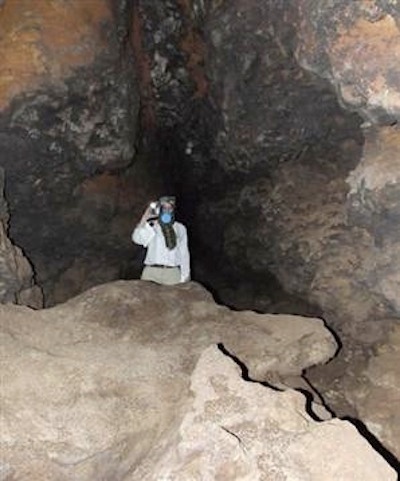
Archaeology News Examiner
Will Hunt
December 10th, 2009 5:14 am ET

Andrew Collins at the "entrance to the Egyptian underworld"

Controversy swirling around a potential recent discovery in Egypt has all the makings of a Hollywood thriller. It began with British author Andrew Collins's apparent discovery of a vast system of caves beneath the Great Pyramids at Giza, which he says may be the portal to the lost underworld referred to in Egyptian funerary texts. Secretary general of the Supreme Council of Antiquities, Dr. Zahi Hawass, has gotten involved, perhaps lending credibility to Collins's find.
Collins first found clues to the cave's exstence in the memoirs of Harry Salt, a 19th century British diplomat and adventurer, who describes an exploration beneath the Giza plateau in 1817, alongside Italian explorer Giovanni Caviglia. According to the memoir, Salt and Caviglia walked "several hundred yards into the cave," before turning around, leaving the rest of the cave unexplored.
Recently, Collins and British Egyptologist Nigel Skinner-Simpson, retraced Salt's steps from 200 years before. Sure enough, in the back of an apparently unrecorded tomb west of the Great Pyramid, they stepped through a fissure in the rock and found themselves in the mouth of an "spacious" cave. They explored as deep as they could, then turned around, citing "unseen pits and hollows, colonies of bats and venomous spiders."
The caves beneath the pyramids, Collins believes, are the inspiration for the Ancient Egyptian belief in the underworld. Collins told Discovery News: "Ancient funerary texts clearly allude to the existence of a subterranean world in the vicinity of the Giza Pyramids."
Ancient Egyptian religion was based on the existence of Duat, the subterranean afterlife ruled by the god Osiris. After a person was given a ritual burial, a form of his spirit would descend underground where his heart would be weighed – judged – by Osiris.
Upon hearing of Collins's report, Hawass dismissed the find with a huff: "There are no new discoveries to be made at Giza. We know everything about the plateau." He then followed with an extended rebuttal on his website. The space that Collins and Skinner-Simpson called a cave, said Hawass, is actually just a rock-cut tomb and they had merely become disoriented. Nothing remains to be found in the tomb, he wrote, as it has been "reported and explored by many scholars," including recently, "by my office, the Supreme Council of Antiquities."
Collins and Simpson both replied in turn, pointing out photographic evidence of the natural cave formations branching off of the tomb. And furthermore asserting that over the course of extensive research, they did not find any modern day reference to the cave – or tomb, as it were. They both challenged Hawass to show them the scholarly reports to which he refers.
Source: Archaeology News Examiner
© 2004-2026 Bill McNulty All Rights Reserved